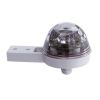Hydreon RG-11 Optical Rain Gauge
Features
- Self-contained, maintenance-free rain sensor with no moving parts
- Sensor can be completely mobile and mounted in any orientation
- DIP switches allow sensor to be set for mode of operation to best match application
- Expedited repair and warranty service
- Lifetime technical support
- More
Overview
The Hydreon RG-11 Rain Gauge is a maintenance-free optical rain sensor that can be used for a wide variety of rainfall monitoring and control applications. The Rain Gauge senses water hitting its outside surface using beams of infrared light, which is the same sensing principle used in millions of automotive rain sensing windshield wiper controls. The complete sensor package is about the size of a tennis ball and completely sealed from the environment.
Design
The optical sensing technology overcomes many of the shortcomings of conventional tipping bucket rain gauges. The sensor works in mobile environments, there is no collecting funnel to clog with leaves, and the round shape makes it essentially self-cleaning.
Modes
The Hydreon RG-11 includes a DIP switch that allows it to be set for the mode of operation that best matches the application.
- Tipping Bucket: Emulates a tipping bucket of the specified size
- It's Raining: Turns on the relay to indicate that it is raining when the rainfall has reached a given intensity
- Condensation Sensor: Detects condensation or frost formation on the surface
- Wiper Control: Rain sensing wiper control at various speeds
- Irrigation Control: Rain Gauge output to inhibit watering
- Drop Detection: Produces a pulse for each drop detected
In The News
Hydreon RG-11 Optical Rain Gauge offers low-cost precipitation sensing
The Hydreon RG-11 optical rain gauge was born from the same technology that automatically triggers automobile windshield wipers. The technologic overlap enabled the production of a low-cost optical precipitation sensor. Hydreon engineers built the sensor due to public demand. “There wasn't one single inquiry that got us to develop the RG-11, but after some time and so many inquiries, we decided it was time to develop a standalone rain sensor,” said Ben Gryskiewicz, Hydreon’s technical office manager. The gauge is a compact, maintenance-free package that is easily mounted on a structure or pole to measure rain. It uses beams of infrared light shining through a clear domed surface to measure precipitation.
Read MoreNWS picks up heavy rainfall in southwest michigan
Field crops in southwest Michigan received heavy rainfall the last few days of June, according to a release from the Michigan State University Extension. This was in contrast with the weather before June 25, which was reliably hot and dry. The counties of Cass, Kalamazoo, St. Joseph and Branch received the heaviest precipitation, with National Weather Service Doppler radar showing rainfall in excess of 5 to 6 inches in those areas. But most of the counties have coarse soils, which should allow for faster water drainage. Given the amount of rain that fell, many fields still have standing water. When combined with warm temperatures, the saturated areas could see crop stand losses and soil nitrogen loss.
Read More33 years later: Northern Hemisphere pollution worsened African drought
Scientists now know that much of the African drought in the 1980s was partly due to pollution that traveled from the Northern Hemisphere, according to a release from University of Washington. The drought was severe enough to cause Lake Chad to very nearly dry out. At the time, Lake Chad’s problems were blamed on overgrazing and poor farming practices. But experts now say that aerosols emanating from U.S. and European factories influenced tropical rain bands, causing them to no longer reach the area. Following clean-air legislation, scientists say the rain bands shifted back, causing the drought to lessen. The University of Washington researchers used historical observations and multiple climate models to determine why the global shift in rainfall occurred.
Read More







